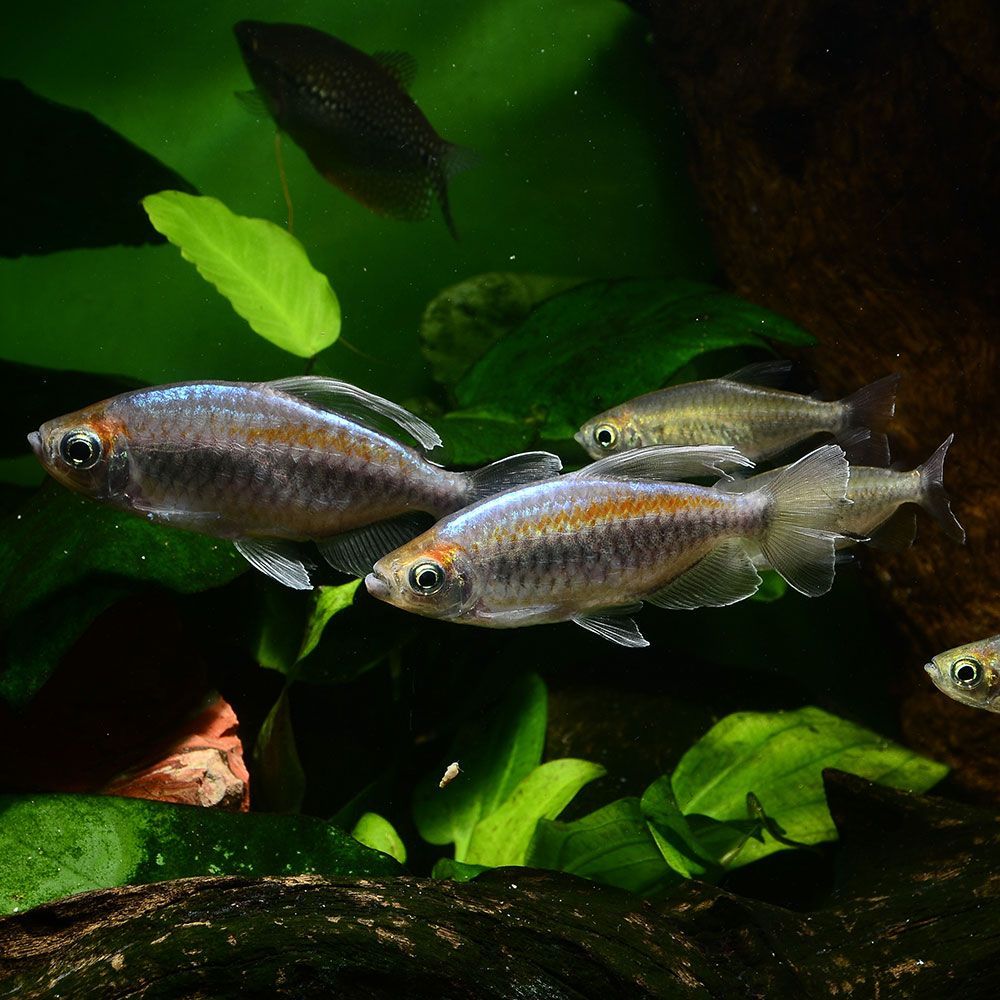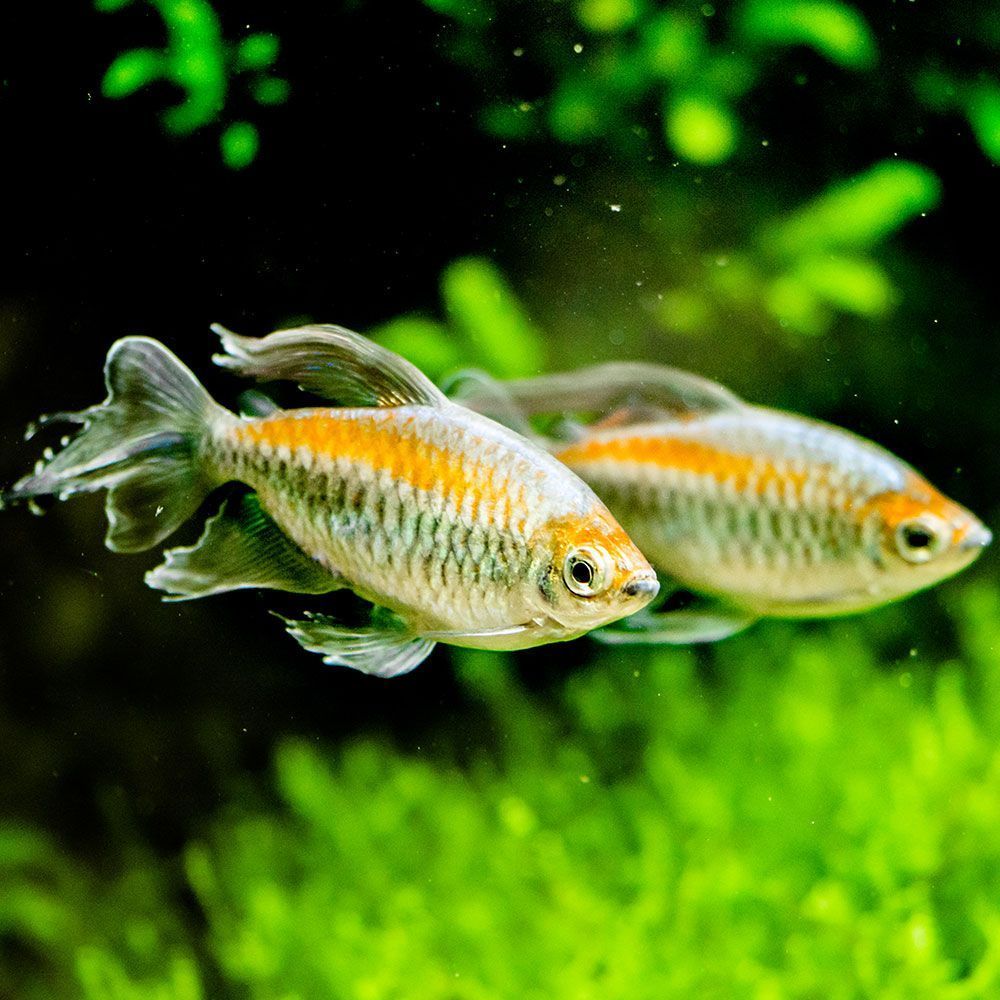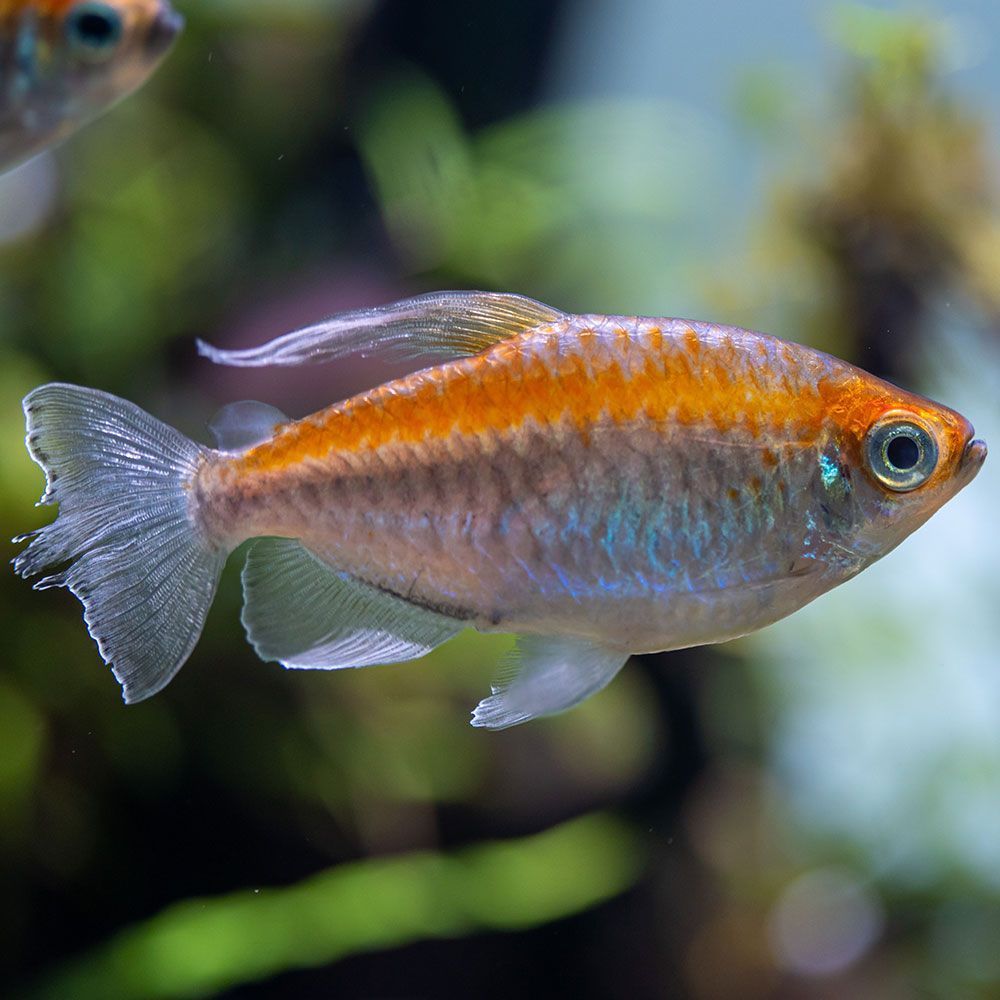The congo tetra is an extremely attractive and sought-for species. Its rainbow-like hues, calm personality, and carefree nature make it a very popular candidate for your aquarium.
Moreover, this fish is not a picky eater and is happy with all kinds of meals. So, if this piqued your curiosity, let’s help you know more about this treat-to-the-eye fish!
What is a Congo Tetra?
Congo tetra is a beautiful silver colored fish which is found in freshwater. Below are some more details about this fish:
| Origin | Congo River Basins and Central African Rivers, Africa |
| Order | Characiformes |
| Family | Alestidae |
| Scientific Name | Phenavogrammus interruptus |
| Common Names | Congo tetra |
| IUCN Red List Status | Least Concern |
| Appearance | Long and flat body, large scales, shimmery iridescent colors with a feathery, translucent tail fin |
| Size | Up to 7.60 cm (3.0 in) |
| Maximum Body Weight | 100 g |
| Lifespan | 3-5 years |
| Temperament | Peaceful when kept in groups |
| Tank Level | Middle and top-dwellers |
| Water Temperature | 73-82 °F (23-28 °C) |
| pH Level | 6.5-7.5 |
| Water Hardness | 3 to 18 dGH |
| Care Level | Moderate |
| Minimum Tank Size | 30 gallons for a group of 6 |
| Tank Environment | Spacious tank, dim lighting, dark substrate, peat moss at the bottom |
| Diet | Omnivorous, anything that fits its mouth, has carnivorous tendencies |
| Tank Mates | Platies, Neon tetras, Guppies, Dwarf Cichlids, Glowlight Tetra, Cardinal Tetra, Harlequin Rasbora |
What is the Natural Habitat of Congo Tetra?
These shiny, freshwater fish have their origin rooted in the waters of the lower and middle basin of the Congo River in the Democratic Republic of Congo of Africa and hence the name.
It is also found in Puerto Rico, Thailand, and the North Atlantic.
Naturally, they are known to be found in streams, tributaries, and swamps with a common inclination towards warm, soft acidic waters and dark substrates of sand, mud, and silt. They’re ordinarily clustered in areas that house tall and lush vegetation.
Last assessed in 2009, the IUCN lists the Congo Tetra as a species of Least Concern, with no immediately foreseeable environmental threats to its population.
Which family does Congo Tetra belong?
The scientific name of the species is Phenacogrammus interruptus. It belongs to the family Alestidae under the order Characiformes.
Fun Fact: Don’t be surprised if the group doesn’t dart to the surface to feed. The species is known to be shy while eating and doesn’t like being watched.
How do Congo Tetra look in the tank?

Similar to most other tetra species, this fish is also bilaterally symmetrical and has a flat and long body.
What is the Size of Congo Tetra?
The males are significantly larger and more colorful than their female counterparts, growing till as long as 7.6 cm (3 in). The female growth is generally restricted to 5.0 cm (2 in).
What is the Color of Congo Tetra?
This fish flaunts rainbow luminescence with its attractive colors. Its body consists of a lovely blue at the top that transforms to red in the middle and then to yellowish-gold before returning to blue again.
It also has flowy, semi-transparent fins that are violet-colored with a shiny white lining.
What are the Features of Congo Tetra?
The middle section of the fish body is pretty tall and the species has significant large scales. Its appearance mostly depends on what kind of light is used and how it reflects light rays off its body. Sometimes it seems blue, violet, turquoise, and even gold.
The fish also has a stripe from its head to the tail. Its auditory system consists of otoliths and a swim bladder, which results in a hearing range of 200-2000 Hz and a hearing threshold of 70 dB.
How do Congo Tetra males differ from females?
The male fish is slightly larger and more vibrantly colored than the female fish. The male tail fin also has a purplish tint, aside from its dorsal and caudal fins being slightly longer and alluring.
Females are usually golden with streaks of green and silver. Females are also a bit more rounded, especially when about to breed.
What is the Behavior of Congo Tetra?
They generally inhabit a peaceful demeanor, especially when bred in groups. Roaming around in groups keeps them in an active state.
What is the Life Span of Congo Tetra?
The life span of a congo tetra ordinarily ranges from 3 to 5 years, provided specific water parameters are maintained. They’re susceptible to poor water quality.
Author’s Note: A congo tetra flaunts its colors to the other gender to exhibit its interest in mating. The brightly colored males compete with other male conspecifics to gain the female fish’s favor.
How to take care of Congo Tetra at Home?

The Congo tetra fish needs an environment that fairly mimics its natural habitat. It is used to warm, still murky and dark waters. Any change in this might cause stress and degrade its beauty. So, let’s learn to create a safe space for them!
What is the Tank Size for Congo Tetra?
Congo tetra is accustomed to uninterrupted swimming space and is, therefore, not recommended for a small aquarium.
Another important thing to note is that these fish are best kept in schools of 6-10, failing which makes them anxious.
Because of this requirement, you need at least a minimum of 30 gallons tank to house such schools. If you’re also planning on introducing tank mates, you might want to upscale the tank to 50 gallons minimum.
What is the Water Chemistry for Congo Tetra?
To give your pet the longest possible life, these water conditions must be maintained:
- pH Levels: 6.5-7.5
- Water Temperature: 73-82 °F (24-28 °C)
- Water Hardness: 3 to 18 dGH
- Ammonia: 0 ppm
- Nitrite: 0 ppm
- Nitrate: Below 30 ppm
What is the Tank Environment for Congo Tetra?
Congo tetra fish is inclined to blackwater settings with low visibility. Even though the species is reasonably hardy, you must meet a specific tank environment for healthy and lively fish.
Do you need Substrate in the tank for Congo Tetra?
The species thrives in dark substrates. You may use mud, sand, or silt to imitate the same for your pet.
Which Types of Plants do you need for Congo Tetra in the aquarium?
It tends to snack on soft leaves, so make sure to use harder plants in your tank. Plastic plants might also serve the purpose but live plants reduce the nitrates. Dense plants give these fish a hiding space for their jittery moments.
What type of Aquarium Lighting is needed for Congo Tetra?
Since these fish are used to blackwater conditions, keep them in a dimly lit room and away from very loud noises. They prefer thisowing to their anxious and sometimes shy nature.
What type of Décor is needed for Congo Tetra?
You do not want to skip on maintaining the aesthetic. Moreover, decorative items like artificial caves, driftwood, and rocks give your fish places to hide easily.
What type of Filtration do you need for Congo Tetra?
Establish appropriate filters like a carbon or standard canister filter to maintain water conditions at their optimum.
What is the Water Flow Rate needed for Congo Tetra?
These fish are known to thrive in stable and still water conditions.
Pro Tip: If the fish is not fed well, the entire group might get moody and scare away tank mates.
What do Congo Tetra eat?
This fish is omnivorous but has a greater inclination towards carnivorous feed. This also helps it show its best colors and stay healthy.
In its natural habitat, it feeds on insects, worms, and algae.
In captivity, commercial fish feed, dried pellets, and flakes may very well serve your purpose. But also include some amount of brine shrimp and bloodworms in their diet, for their dose of protein and fatty acids. Vegetables may serve as a source of vitamins.
It would be best to feed it in small quantities several times a day. Remember, it is shy to eat in front of you, so step away and let it enjoy its meal!
What are the Tank Mates required for Congo Tetra?
It is a community fish, peaceful and tolerant, especially when kept in schools. It is very unlikely to be aggressive towards anyone, be it their own species or any other.
But don’t keep it with larger and more aggressive species, as they might end up bullying it. So, here’s a list of suitable tank mates for your congo tetra:
- Dwarf Cichlids
- Neon Tetras
- Harlequin Rasboras
- Platies
- Rainbowfish
- Corydoras Catfish
- Royal plecos
- Cardinal Tetras
- Mollies
What Tank Mates to avoid for Congo Tetra?
You must not keep the fish with large, hyperactive, and aggressive-natured fishes. Even loud noises make them anxious and cause them to hide.
The following tank mates are a no-go either because of their size or aggressive nature:
- Tiger barbs
- Oscar Fish
- Flowerhorn Fish
- Aggressive Cichlids
What are the Common Diseases associated with Congo Tetra?
It is a resilient species and usually doesn’t give in to diseases. However, drastic changes in the aquarium may lead to a few ailments as follows:
| Disease Name | Causes | Symptoms | Treatment |
|---|---|---|---|
| Ich | Parasitic infection (due to Ichthyophthirius multifiliis) | Flashing, white spots, loss of appetite, abnormal hiding. | Adding aquarium salt, monitoring water temperature, and medications. |
| Skin flukes | Parasitic infection | Excess mucus, red spots, breathing troubles, flashing, missing scales, lethargy, appetite loss | Improve water quality, maintain a balanced diet, oral medicines and injections, medicated bath |
| Columnaris | Bacterial infection | Gray or white patches, frayed fins, appetite loss, lethargy | Elevate water quality, diminish stress, antibiotics |
| Fin rot | Bacterial infection | Frayed or disintegrated fins, discolored or reddened fins, lethargy | Improve water quality, remove physically injurious objected, antibiotic |
| Swim bladder disease | Bacterial infection, high concentration of nitrates, sudden temperature fluctuation | Fish floats in tank surface, abnormal swimming patterns | Enhance water quality, make the fish fast for a few days, feed boiled and skinned peas then, pay attention to temperature |
Quick Tip: Diseases won’t be a problem with this species as long as you provide appropriate water conditions, a well-balanced diet, and suitable mates!
How to breed Congo Tetra in an aquarium?
This species breeds spontaneously, even if you don’t induce it. But, for breeding under controlled conditions, it usually requires a breeding tank of about 15-20 gallons. They’re very fertile, producing about 300 eggs at a time.
How to prepare your tank for breeding Congo Tetra?
You can aid the process by providing filtered, soft, acidic water conditions in the breeding tank. Introduce a boiled peat moss substrate of about 1 inch and Java thickets on top to have adequate protection for the eggs.
What is the Mating Process for Congo Tetra?
Introduce a compatible pair of Congo tetras or a group into the breeding tank while maintaining darkness for at least 8 hours to stimulate spawning. An appropriate gender mix ratio would be two males for every female.
The male fish dances and shows off its brilliant colors to attract the female fish. If the female egg layer gets impressed, she plants her eggs in the substrate, rocks, or spawning mops. The male fish follows after and spawns over the eggs.
Once spawned, be sure to remove the pair, or they will eat their own eggs.
When do Congo Tetra eggs hatch?
The eggs of Congo tetra hatch in around 5-8 days from spawning. The fry hatches and lives on its egg yolk sac. Once the fry starts freely swimming, feed them infusoria for 2 days before moving to baby brine shrimp.
Congo tetra fries grow quickly and reach about an inch in length in just 2 weeks. Within 3 months, they’ll reach 2 inches and exhibit vivid tinctures.
At this point, it is visibly possible to identify the gender of the young fish. However, they sexually mature and breed only once they reach 6 months of age.
Breeding Tip: Make sure the water temperature is stable at 77 °F (25 °C) in the breeding tank.
What are the things to consider while buying Congo Tetra?
Congo tetras are easily found in all pet stores but are extremely expensive. Before buying, pay specific attention if the owner has prioritized the health of the fish. If the fish doesn’t look healthy, go to a different store.
A word from FishInAquarium
Congo tetra is an appealing addition adding to your aquarium’s aesthetic. It is easy to look after, but only if you’ve successfully established the optimal water parameters. With its strikingly bright colors, it’s a sight to watch as it swims around.
Now, if you have further questions, feel free to mail us. And if you happen to know a fellow aquarist, don’t forget to share this with them.


